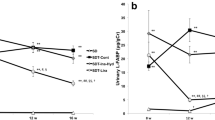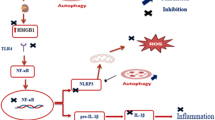Abstract
Aluminum is well recognized as a nephrotoxic agent. Its hazardous effects arise from the high risk of daily exposure. The consumption of fructose also represents a critical health issue that might negatively impact different organs, including the kidneys. To pursue our previous work, this study aimed to investigate the potential renoprotective effects of glycyrrhizic acid (GLYA) on aluminum-induced nephrotoxicity in insulin-resistant rats. Insulin resistance (IR) was induced by adding fructose (10%) in drinking water for 18 weeks. Male Wistar rats were divided into five groups: control (CTRL), aluminum chloride (ALM, 34 mg/kg/day), fructose (FRCT), aluminum plus fructose (AL/FR), and GLYA (rats received AL/FR and treated with 40 mg/kg GLYA daily). AL/FR resulted in abnormal renal function tests and renal tissue injury. This was associated with increased oxidative stress and inflammation in the renal tissue. Moreover, the expressions of the toll-like receptor 4 (TLR4) and its adaptor proteins were increased in AL/FR group. The administration of GLYA mollified AL/FR-induced renal injury, oxidative stress, activation of the TLR4 signaling pathway, and inflammation. In conclusion, we provide evidence for the promising renoprotective effect of GLYA against AL/FR-induced kidney damage in rats. The renoprotection is attributed to the suppression of oxidative stress and inhibition of the TLR4/NF-κB signaling pathway in the kidneys.





Similar content being viewed by others
References
Abdel Moneim AE, Othman MS, Mohmoud SM, El-Deib KM (2013) Pomegranate peel attenuates aluminum-induced hepatorenal toxicity. Toxicol Mech Methods 23:624–633
Akira S, Takeda K (2004) Toll-like receptor signalling. Nat Rev Immunol 4:499–511
Al Dera HS (2016) Protective effect of resveratrol against aluminum chloride induced nephrotoxicity in rats. Saudi Med J 37:369–378
Al Kahtani MA, Abdel-Moneim AM, El-Sayed WM (2014) The influence of taurine pretreatment on aluminum chloride induced nephrotoxicity in Swiss albino mice. Histol Histopathol 29:45–55
Ali NM, Mahmoud AAA, Mahmoud MF, El Fayoumi HM (2019) Glycyrrhizic acid and silymarin alleviate the neurotoxic effects of aluminum in rats challenged with fructose-induced insulin resistance: possible role of toll-like receptor 4 pathway. Drug Chem Toxicol 42:210–219
Aoyama M, Isshiki K, Kume S, Chin-Kanasaki M, Araki H, Araki S, Koya D, Haneda M, Kashiwagi A, Maegawa H, Uzu T (2012) Fructose induces tubulointerstitial injury in the kidney of mice. Biochem Biophys Res Commun 419:244–249
Belaid-Nouira Y, Bakhta H, Haouas Z, Flehi-Slim I, Ben Cheikh H (2013) Fenugreek seeds reduce aluminum toxicity associated with renal failure in rats. Nutr Res Pract 7:466–474
Dharnidharka VR, Kwon C, Stevens G (2002) Serum cystatin C is superior to serum creatinine as a marker of kidney function: a meta-analysis. Am J Kidney Dis 40:221–226
El-Kenawy Ael M, Hussein Osman HE, Daghestani MH (2014) Role of propolis (bee glue) in improving histopathological changes of the kidney of rat treated with aluminum chloride. Environ Toxicol 29:1000–1010
Feng C, Wang H, Yao C, Zhang J, Tian Z (2007) Diammonium glycyrrhizinate, a component of traditional Chinese medicine Gan-Cao, prevents murine T-cell-mediated fulminant hepatitis in IL-10- and IL-6-dependent manners. Int Immunopharmacol 7:1292–1298
Fiore C, Eisenhut M, Krausse R, Ragazzi E, Pellati D, Armanini D, Bielenberg J (2008) Antiviral effects of Glycyrrhiza species. Phytother Res 22:141–148
Flaten TP (2001) Aluminium as a risk factor in Alzheimer’s disease, with emphasis on drinking water. Brain Res Bull 55:187–196
Fujisawa Y, Sakamoto M, Matsushita M, Fujita T, Nishioka K (2000) Glycyrrhizin inhibits the lytic pathway of complement--possible mechanism of its anti-inflammatory effect on liver cells in viral hepatitis. Microbiol Immunol 44:799–804
Gersch MS, Mu W, Cirillo P, Reungjui S, Zhang L, Roncal C, Sautin YY, Johnson RJ, Nakagawa T (2007) Fructose, but not dextrose, accelerates the progression of chronic kidney disease. Am J Physiol Ren Physiol 293:F1256–F1261
Gumpricht E, Dahl R, Devereaux MW, Sokol RJ (2005) Licorice compounds glycyrrhizin and 18beta-glycyrrhetinic acid are potent modulators of bile acid-induced cytotoxicity in rat hepatocytes. J Biol Chem 280:10556–10563
Guo Y, Wang S, Wang Y, Zhu T (2016) Silymarin improved diet-induced liver damage and insulin resistance by decreasing inflammation in mice. Pharm Biol 54:2995–3000
Hayashi H, Sudo H (2009) Economic importance of licorice. Plant Biotechnol 26:101–104
Hemmati F, Ghasemi R, Mohamed Ibrahim N, Dargahi L, Mohamed Z, Raymond AA, Ahmadiani A (2014) Crosstalk between insulin and Toll-like receptor signaling pathways in the central nervous system. Mol Neurobiol 50:797–810
Hibasami H, Iwase H, Yoshioka K, Takahashi H (2006) Glycyrrhetic acid (a metabolic substance and aglycon of glycyrrhizin) induces apoptosis in human hepatoma, promyelotic leukemia and stomach cancer cells. Int J Mol Med 17:215–219
Hoever G, Baltina L, Michaelis M, Kondratenko R, Baltina L, Tolstikov GA, Doerr HW, Cinatl J Jr (2005) Antiviral activity of glycyrrhizic acid derivatives against SARS-coronavirus. J Med Chem 48:1256–1259
Hou S, Zheng F, Li Y, Gao L, Zhang J (2014) The protective effect of glycyrrhizic acid on renal tubular epithelial cell injury induced by high glucose. Int J Mol Sci 15:15026–15043
Kizhner T, Werman MJ (2002) Long-term fructose intake: biochemical consequences and altered renal histology in the male rat. Metabolism 51:1538–1547
Kutlubay R, Oguz EO, Guven C, Can B, Sinik Z, Tuncay OL (2007) Histological and ultrastructural evidence for protective effects on aluminium-induced kidney damage by intraperitoneal administration of alpha-tocopherol. Int J Toxicol 26:95–101
Lin JC (2003) Mechanism of action of glycyrrhizic acid in inhibition of Epstein-Barr virus replication in vitro. Antivir Res 59:41–47
Lin JL, Yang YJ, Yang SS, Leu ML (1997) Aluminum utensils contribute to aluminum accumulation in patients with renal disease. Am J Kidney Dis 30:653–658
Livak KJ, Schmittgen TD (2001) Analysis of relative gene expression data using real-time quantitative PCR and the 2(-Delta Delta C(T)) method. Methods 25:402–408
Mahieu ST, Gionotti M, Millen N, Elias MM (2003) Effect of chronic accumulation of aluminum on renal function, cortical renal oxidative stress and cortical renal organic anion transport in rats. Arch Toxicol 77:605–612
Matthews DR, Hosker JP, Rudenski AS, Naylor BA, Treacher DF, Turner RC (1985) Homeostasis model assessment: insulin resistance and beta-cell function from fasting plasma glucose and insulin concentrations in man. Diabetologia 28:412–419
Mudge DW, Johnson DW, Hawley CM, Campbell SB, Isbel NM, van Eps CL, Petrie JJ (2011) Do aluminium-based phosphate binders continue to have a role in contemporary nephrology practice? BMC Nephrol 12:20
Nakayama T, Kosugi T, Gersch M, Connor T, Sanchez-Lozada LG, Lanaspa MA, Roncal C, Perez-Pozo SE, Johnson RJ, Nakagawa T (2010) Dietary fructose causes tubulointerstitial injury in the normal rat kidney. Am J Physiol Ren Physiol 298:F712–F720
Oudot C, Lajoix AD, Jover B, Rugale C (2013) Dietary sodium restriction prevents kidney damage in high fructose-fed rats. Kidney Int 83:674–683
Qiao Y, Xu L, Tao X, Yin L, Qi Y, Xu Y, Han X, Tang Z, Ma X, Liu K, Peng J (2018) Protective effects of dioscin against fructose-induced renal damage via adjusting Sirt3-mediated oxidative stress, fibrosis, lipid metabolism and inflammation. Toxicol Lett 284:37–45
Sargazi M, Shenkin A, Roberts NB (2006) Aluminium-induced injury to kidney proximal tubular cells: effects on markers of oxidative damage. J Trace Elem Med Biol 19:267–273
Sen S, Roy M, Chakraborti AS (2011) Ameliorative effects of glycyrrhizin on streptozotocin-induced diabetes in rats. J Pharm Pharmacol 63:287–296
Sil R, Ray D, Chakraborti AS (2013) Glycyrrhizin ameliorates insulin resistance, hyperglycemia, dyslipidemia and oxidative stress in fructose-induced metabolic syndrome-X in rat model. Indian J Exp Biol 51:129–138
Smith KD (2009) Toll-like receptors in kidney disease. Curr Opin Nephrol Hypertens 18:189–196
Takii H, Kometani T, Nishimura T, Nakae T, Okada S, Fushiki T (2001) Antidiabetic effect of glycyrrhizin in genetically diabetic KK-ay mice. Biol Pharm Bull 24:484–487
Wu CH, Chen AZ, Yen GC (2015) Protective effects of glycyrrhizic acid and 18beta-glycyrrhetinic acid against cisplatin-induced nephrotoxicity in BALB/c mice. J Agric Food Chem 63:1200–1209
Zakaria S, Hasan RA, Mahmoud MF, El Fayoumi HM, Mahmoud AAA (2020) The concurrent exposure to aluminium and fructose induces liver injury in rats: protection by monoammonium glycyrrhizinate. Clin Exp Pharmacol Physiol 47:809–820
Zheng QZ, Lou YJ (2003) Pathologic characteristics of immunologic injury in primary cultured rat hepatocytes and protective effect of glycyrrhizin in vitro. Acta Pharmacol Sin 24:771–777
Acknowledgments
The authors acknowledge Dr. Rehab Hasan, Department of Histology, Faculty of Medicine, Al-Azhar University, Egypt, for her great effort in the histopathological examination.
Author information
Authors and Affiliations
Contributions
MFM, HME, and AAAM conceived and designed research. NAE conducted the experiments. NAE and AAAM analyzed the data. NAE and AAAM wrote the first draft of manuscript. MFM, HME, and AAAM revised and edited the manuscript. All the authors read and approved the manuscript. The authors declare that all data were generated in-house and that no paper mill was used.
Corresponding author
Ethics declarations
The study protocol and animal handling procedures were approved by the Ethical Committee for Animal Handling at Zagazig University (ECAH ZU), Faculty of Pharmacy, Zagazig University, Egypt based on the recommendations of the Weatherall report.
Conflict of interest
The authors declare that there is no conflict of interest.
Additional information
Publisher’s note
Springer Nature remains neutral with regard to jurisdictional claims in published maps and institutional affiliations.
Rights and permissions
About this article
Cite this article
Emara, N.A., Mahmoud, M.F., El Fayoumi, H.M. et al. The renoprotective effect of glycyrrhizic acid in insulin-resistant rats exposed to aluminum involves the inhibition of TLR4/NF-κB signaling pathway. Naunyn-Schmiedeberg's Arch Pharmacol 394, 863–872 (2021). https://doi.org/10.1007/s00210-020-02012-y
Received:
Accepted:
Published:
Issue Date:
DOI: https://doi.org/10.1007/s00210-020-02012-y




